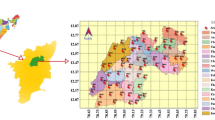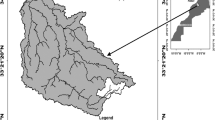Abstract
Land use and intrinsic soil properties play vital role in variability of heavy metals and magnetic susceptibility within a landscape. This study was conducted to use multiple linear regressions modeling to explore the variability of magnetic susceptibility and heavy metals within five different land uses and to find the interaction of these variables with intrinsic soil properties in Ahvaz district, Khuzestan Province, Southern Iran. Five land uses included urban area, agricultural land, steel company, Zargan Power Plant, and Ramin Power Plant. Twenty soil samples from each land use and totally one hundred samples from 0 to 5 cm topsoil were randomly collected. Some chemical and physical soil properties, magnetic susceptibility as well as concentration of some heavy metals were measured. The results showed that significant correlations were found between heavy metals and magnetic susceptibility at low frequency (χlf), showing high capability of magnetic susceptibility for prediction of heavy metals. Calcium carbonate equivalent and soil organic matter (SOM) showed negative correlation with χlf, while SOM and clay content had substantial influences on variability of heavy metals in the studied area. The results of the comparison among land uses showed that Cr, Ni were the highest in agricultural land because of the application of the sewage sludge and fertilizers, while the metals (ZN, Mn, Cu, Co and Fe) and χlf were the highest in steel company due to the industrial activities. Multiple linear regression analysis showed that the combination of soil properties and magnetic susceptibility could explain 94, 62, 69, 53, 81, 77 and 57% of the variability in Fe, Mn, Cu, Zn, Ni, Co and Cr, respectively.





Similar content being viewed by others
References
Ajayi A, Kamson OF (1983) Determination of lead in roadside dust in Lagos city by atomic absorption spectrophotometry. Environ Int 9:397–400
Ayoubi S, Sahrawat KL (2011) Comparing multivariate regression and artificial neural network to predict barley production from soil characteristics in northern Iran. Arch Agron Soil Sci 57:549–565
Ayoubi S, Jalalian A, Eghbal MK (2002) Role of pedogenesis in distribution of magnetic susceptibility in two aridisols from Isfahan, central Iran. In: Angel F, Ortiz R, Mermut AR (eds) International conference of SUMASS, Cartagena, Murcia, pp 49–50
Ayoubi S, Ahmadi M, Abdi MR, Abbaszadeh Afshar F (2012) Relationships of Cs-137 inventory with magnetic measures of calcareous soils of hilly region in Iran. J Environ Radioact 112:45–51
Ayoubi S, Amiri S, Tajik S (2014) Lithogenic and anthropogenic impacts on soil surface magnetic susceptibility in an arid region of central Iran. Arch Agron Soil Sci 60:1467–1483
Biasiolia M, Barberisb R, Ajmone-Marsan F (2006) The influence of a large city on some soil properties and metals content. Sci Total Environ 356:154–164
Burt R (2004) Soil Survey Laboratory Methods Manual. USDA-Natural Resources Conservation Service, Lincoln
Caitcheon G (1993) Sediment source tracing using environmental magnetism: a new approach with examples from Australia. Hydrol Process 7:349–358
Chan LS, Yeung CH, Yim WWS, Or OL (1998) Correlation between magnetic susceptibility and distribution of heavy metals in contaminated sea-floor sediments of Hong Kong Harbour. Environ Geol 36:77–86
Chan LS, Ng SL, Davis AM, Yim WWS, Yeung CH (2001) Magnetic properties and heavy-metal contents of contaminated seabed sediments of Penny’s Bay, Hong Kong. Mar Pollut Bull 42:569–583
Dankoub Z, Ayoubi S, Khademi H, Lu SG (2011) Spatial distribution of magnetic properties and selected heavy metals as affected by land use in calcareous soils of the Isfahan Region, Central Iran. Pedosphere 22:33–47
Davies B (1997) Heavy metal contaminated soils in an old industrial area of Wales, Great Britain: Source identification through statistical data interpretation. Water Air Soil Pollut 94:85–98
Day PR (1965) Particle fractionation and particle-size analysis. In: Black CA (ed) Methods of soil analysis, Part 1. ASA, Madison
Doelsch E, Deroche B, Van de Kerchove V (2006) Impact of sewage sludge spreading on heavy metal speciation in tropical soils (Reunion, Indian Ocean). Chemosphere 65:286–293
Facchinelli A, Sacchi E, Mallen L (2001) Multivariate statistical and GIS-based approach to identify heavy metal sources in soils. Environ Pollut 114:313–324
Flanders PJ (1994) Collection, measurement and analysis of airborne magnetic particulates from pollution in the environment (invited). J Appl Phys 75:5931–5936
Freund RJ, Littell RC (2000) SAS system for regression. SAS Institute, Cary
Gallego JLR, Ordonez A, Loredo J (2002) Investigation of trace element sources from an industrialized area (Aviles, northern Spain) using multivariate statistical methods. Environ Int 27:589–596
Gelisli K, Aydin A (1998) Investigations of environmental pollution using magnetic susceptibility measurements. Eur J Environ Eng Geophys 3:53–61
Hoffmann V, Knab M, Appel E (1999) Magnetic susceptibility mapping of roadside pollution. J Geochem Explor 66:313–326
Holford ICR, Mattingly GEG (1975) Surface areas of calcium carbonate in soils. Geoderma 13:247–255
Hu XF, Yu S, Rong Y, Li XQ, Zhang GL (2007) Magnetic properties of the urban soils in Shanghai and their environmental implications. Catena 70:428–436
Karimi AR, Khademi H, Ayoubi S (2013) Magnetic susceptibility and morphological characteristics of a loess–paleosol sequence in northeastern Iran. Catena 101:56–60
Karimi R, Ayoubi S, Jalalian A, Sheikh- Hosseini AR, Afyuni M (2011) Relationships between magnetic susceptibility and heavy metals in urban topsails in the arid region of Isfahan, central Iran. J Appl Geophys 74:1–7
Kocher B, Wessolek G, Stoffegen H (2005) Water and heavy metal transport in roadside soils. Pedosphere 15:746–753
Kukier U, Ishak CF, Sumner ME, Miller WP (2003) Composition and element solubility of magnetic and non-magnetic fly ash fractions. Environ Pollut 123:255–266
Kulkarni GE, Muley AA, Deshmukh NK, Bhalchandra PU (2018) Multivariate statistical techniques for prediction of tree and shrub species plantation using soil parameters. Model Earth Syst Environ. https://doi.org/10.1007/s40808-017-0408-7
Lecoanet H, Lévêque F, Ambrosi JP (2001) Magnetic properties of salt-marsh soils contaminated by iron industry emissions (southeast France). J Appl Geophys 48:67–81
Li X, Poon CS, Liu PS (2001) Heavy metal contamination of urban soil and street dusts in Hong Kong. Appl Geochem 16:1361–1368
Lu SG (2000) Lithological factors affecting magnetic susceptibility of subtropical soils, Zhejiang Province, China. Catena 40:359–373
Lu SG, Bai SQ (2006) Study on the correlation of magnetic properties and heavy metals content in urban soils of Hangzhou City, China. J Appl Geophys 60:1–12
Lu SG, Bai SQ, Cai JB, Xu C (2005) Magnetic properties and heavy metal contents of automobile emission particulates. J Zhejiang Univ Sci 6:731–735
Lu SG, Bai SQ, Xue QF (2007) Magnetic properties as indicators of heavy metals pollution in urban topsoils: a case study from the city of Luoyang, China. Geophys J Int 171:568–580
Lu SG, Bai SQ, Fu LX (2008) Magnetic properties as indicators of Cu and Zn contamination in soils. Pedosphere 18:479–485
Magiera T, Kapička A, Petrovsky E, Strzyszcz Z, Fialova H, Rachwa M (2008) Magnetic anomalies of forest soils in the Upper Silesia–Northern Moravia region. Environ Pollut 156:618–627
Marwick B (2005) Element concentrations and magnetic susceptibility of anthrosols: indicators of prehistoric human occupation in the in land Pilbara, Western Australia. J Archeol Sci 32:1357–1368
Mathe V, Leveque F (2003) High resolution magnetic survey for soil monitoring: detection of drainage and soil tillage effects. Earth Planet Sci Lett 212:241–251
Mermut AR, Jain JC, Song L, Kerrich R, Kozak L, Jana L S (1996) Trace element concentrations of selected soils and fertilizers in Saskatchewan, Canada. J Environ Qual 25:845–853
Mico C, Recatala L, Peris M, Sanchez J (2006) Assessing heavy metal sources in agricultural soils of an European Mediterranean area by multivariate analysis. Chemosphere 65:863–872
Mokarram M (2016) Modeling of multiple regression and multiple linear regressions for prediction of groundwater quality (case study: north of Shiraz). Model Earth Syst Environ 2:3
Mokarram M, Najafi-Ghiri M, Negahban S, Roshan G (2016) Relationship between landform and soil salinity in the surface and subsurface soils (case study: Southeast of Fars Province, Iran). Model Earth Syst Environ 2:16
Mokhtari Karchegani P, Ayoubi S, Lu SG, Honarju N (2011) Use of magnetic measures to assess soil redistribution following deforestation in hilly region. J Appl Geophys 75:227–236
Naimi S, Ayoubi S (2013) Vertical and horizontal distribution of magnetic susceptibility and metal contents in an industrial district of central Iran. J Appl Geophys 96:55–66
Nanos N, Rodríguez Martín JA (2012) Multiscale analysis of heavy metal contents in soils: spatial variability in the Duero river basin (Spain). Geoderma 189–190:554–562
Navas A, Machin J (2002) Spatial distribution of heavy metals and arsenic in soils of Aragon (northeast Spain): controlling factors and environmental implications. Appl Geochem 17:961–973
Nicholson FA, Smith SR, Alloway BJ, Carlton-Smith C, Chambers BJ (2003) An inventory of heavy metals inputs to agricultural soils in England and Wales. Sci Total Environ 311:205–219
Ozay Tekin H, Uyanoz R (2012) Trace and rarc earth element (REE) status of carsamba fan soils in the ancient Konya lake region, Turkey. Afr J Agric Res 7:1110–1117
Pazand K (2016) Geochemistry and multivariate statistical analysis for fluoride occurrence in groundwater in the Kuhbanan basin, Central Iran. Model Earth Syst Environ (2016) 2:72
Petrovsky E, Kapicka A, Jordanova N, Knab M, Hoffmann V (2000) Low field magnetic susceptibility: a proxy method of estimating increased pollution of different environmental systems. Environ Geol 39:312–318
Qishlaqi A, Moore F (2007) Statistical analysis of accumulation and sources of heavy metals occurrence in agricultural soils of Khoshk River banks, Shiraz, Iran. Am Eur J Agric Environ Sci 2:565–573
Rahimi MR, Ayoubi S, Abdi MR (2013) Magnetic susceptibility and Cs-137 inventory variability as influenced by land use change and slope positions in a hilly, semiarid region of west-central Iran. J Appl Geophys 89:68–75
Rashed MN (2010) Monitoring of contaminated toxic and heavy metals, from mine tailings through age accumulation, in soil and some wild plants at Southeast Egypt. J Hazard Mater 178:739–746
Rodríguez Martín JA, Lopez Arias M, Grau Corb JM (2006) Heavy metals contents in agricultural top-soils in the Ebro basin (Spain). Application of the multivariate geostatistical methods to study spatial variations. Environ Pollut 144:1001–1012
Romic M, Romic D (2003) Heavy metals distribution in agricultural topsoils in urban area. Environ Geol 43:795–805
Rustullet J (1996) Estudi de sols fersial. lattics de la serralada litoral catalana: Vora NE del Mass del Garraf, Ph.D. Dissertation. University of Barcelona, Barcelona
Seyedmohammadi J, Esmaeelnejad L, Ramezanpour H (2016) Determination of a suitable model for prediction of soil cation exchange capacity. Model Earth Syst Environ 2:156
Singer MJ, Verousb KL, Fine P, Tenpas J (1996) A conceptual model for the enhancement of magnetic susceptibility in soils. Quatern Int 34(36):243–248
Strzyszcz Z, Magiera T (1998) Magnetic susceptibility and heavy metals contamination in soils of Southern Poland. Phys Chem Earth 23(9–10):1127–1131
Swan ARH, Sandilands M (1995) Introduction to geological data analysis. Blackwell Science, Oxford
Swartjes FA (1999) Risk-based assessment of soil and groundwater quality in the Netherlands: standards and remediation urgency. Risk Anal 19:1235–1249
Taghipour M, Ayoubi S, Khadmei H (2011) Contribution of lithologic and anthropogenic factors to surface soil heavy metals in western Iran using multivariate geostatistical analyses. Soil Sediment Contam 28:921–937
Valaee M, Ayoubi S, Khormali F, Lu SG, Karimzadeh H (2016) Using magnetic susceptibility to discriminate between soil moisture regimes in selected loess and loess-like soils in northern Iran. J Appl Geophys 127(2):23–30
Walkley A, Black AI (1934) An examination of the Degtjareff method for determining soil organic matter, and a proposed modification of the chromic acid titration method. Soil Sci 37:29–38
Wang XS, Qin Y (2005) Correlation between magnetic susceptibility and heavy metals in urban topsoil: a case study from the city of Xuzhou, China. Environ Geol 49:10–18
Zhang C (2006) Using multivariate analyses and GIS to identify pollutants and their spatial patterns in urban soils in Galway, Ireland. Environ Pollut 142:501–511
Author information
Authors and Affiliations
Corresponding author
Rights and permissions
About this article
Cite this article
Ayoubi, S., Jabbari, M. & Khademi, H. Multiple linear modeling between soil properties, magnetic susceptibility and heavy metals in various land uses. Model. Earth Syst. Environ. 4, 579–589 (2018). https://doi.org/10.1007/s40808-018-0442-0
Received:
Accepted:
Published:
Issue Date:
DOI: https://doi.org/10.1007/s40808-018-0442-0




